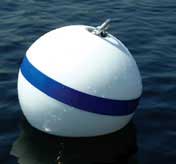Using Mooring Buoys

It is not always convenient for a boat owner to secure their boat at a dock. On those occasions the person may choose to anchor their boat in a safe location. However, anchors have been known to slip during storms and the owner may awake to find the boat drifted away during the night to destinations unknown.
The most reliable way to prevent this is to attach the boat to a mooring buoy. Mooring buoys are secured to the ground by either being drilled into the waterway bed or by being attached to a heavy mushroom or similar anchor with enough weigh to hold the boat in place. To ensure the buoys do not hinder the safety of others there are restrictions and requirements placed on them.
Single Recreational Mooring Buoys
The State does not require a permit for single recreational mooring buoys. The U.S. Army Corps of Engineers has granted general permit approval through the Maryland State Programmatic General Permit or Nationwide Permit 10 for single recreational mooring buoys pursuant to Section 10 of the Rivers and Harbors Act of 1899 subject to certain terms and conditions. The terms and conditions of these authorizations can be found at
Maryland Permits (army.mil). Buoys not authorized by one of these general permits would require an alternative type of authorization from the Corps.
Mooring buoys shall be colored white and shall have a horizontal blue band around the circumference of the buoy, centered midway between the top of the buoy and the water line. Also, a mooring buoy may bear ownership identification, by using the state boating registration number, documentation number, or vessel name.
Group Recreational Mooring Buoys
https://dnr.maryland.gov/boating/Pages/moorings_group.aspx
The State requires that group moorings (Moorings consisting of 3 or more vessels under the control of one entity) be registered with the Maryland Department of Natural Resources. To register your group mooring please complete the Group Mooring Registration Form and send to MDNR.
https://dnr.maryland.gov/boating/Documents/group_mooring_reg_form.pdf
Group Recreational Mooring Buoys are also subject to the U.S. Army Corps of Engineers regulatory jurisdiction pursuant to Section 10 of the Rivers and Harbors Act of 1899.
Commercial Mooring Buoys
https://dnr.maryland.gov/boating/Pages/srmbuoys.aspx
A Commercial Mooring Buoy refers to a buoy in which the owner or permit holder charges a fee or other form of consideration for use of the buoy to secure, berth or moor a vessel in the waters of the State.
Commercial Mooring Buoys are subject to the U.S. Army Corps of Engineers regulatory jurisdiction pursuant to Section 10 of the Rivers and Harbors Act of 1899.
The Maryland Department of the Environment (MDE) and the Corps have a joint permit process Therefore, the process should be started by contacting MDE - Tidal Wetland Division (410-537-3837.
Mooring Buoys - Placement & Placement Restrictions
Moorings shall be placed in a manner where:

- the area encompassed by mooring buoy as well as the arc of the swing of the attached vessel does not extend more than one-third the open water distance from the mean high-water line on one shore to the mean high-water line on the opposite shore,
- the mooring buoy and the arc of the swing of the attached vessel does not impede or obstruct access to the land of any riparian property owner, the access and proper use of any public access point, or otherwise hinder the orderly access to and use of waterways by the general public,
- that the mooring buoy and arc of swing of the attached vessel does not extend into any marked or unmarked channel, including channels as designated by and maintained by the federal government, the State or local authority, or otherwise extends into areas used for general navigation.
- Mooring buoys and arc of swing of the attached vessel may not be placed in a manner that interferes with the operation of or access through any bridge.
Mooring buoys may not be established in the following areas:
- Public shellfish beds
- Private shellfish beds, unless permission is obtained from the lease-holder;
- Cable crossing areas;
- Designated beach and swim areas in the Severn River; or in
- Controlled ski areas in the Severn River and South Rivers in Anne Arundel County.
Kent County, the City of Annapolis and the towns of Oxford and St. Michael's, Maryland have local mooring requirements that also must be met.
NOTE: for awareness when considering possible locations for siting mooring buoys, the Virginia Institute of Marine Science maintains a web site:
https://www.vims.edu/research/units/programs/sav/access/maps/index.php
where SAV has been mapped. Generally, care should be exercised such that no mooring buoy(s) be placed in, or within 25 feet of SAV areas as mapped/verified.
Questions:
If you have any questions regarding mooring buoys, please contact Jeannine Moaney, Department of Natural Resources Fishing and Boating Services at 410-260-8417.
The Corps contact info is:
U.S. Army Corps of Engineers, Baltimore District
Regulatory Branch (CENAB-OPR)
2 Hopkins Plaza
Baltimore, Maryland 21201
410-962-3670
Email:
[email protected]